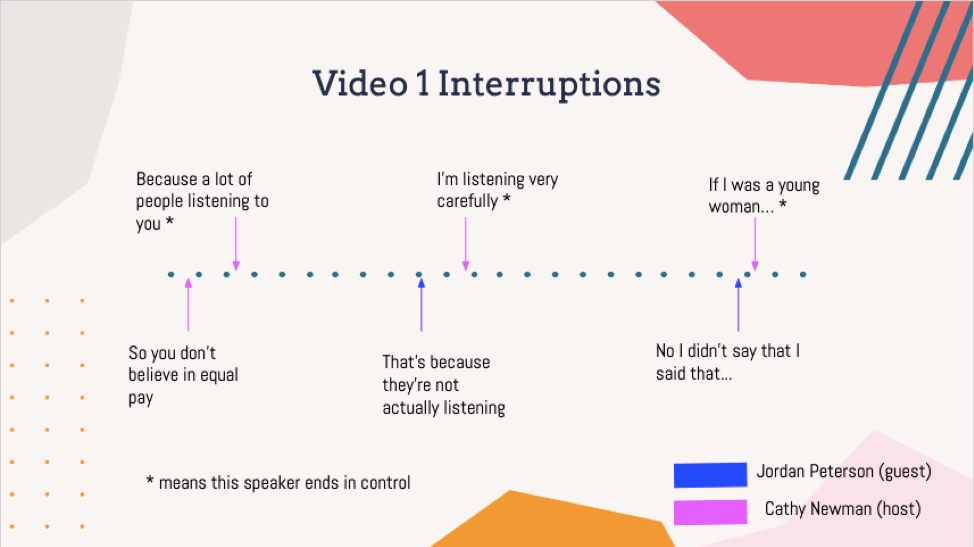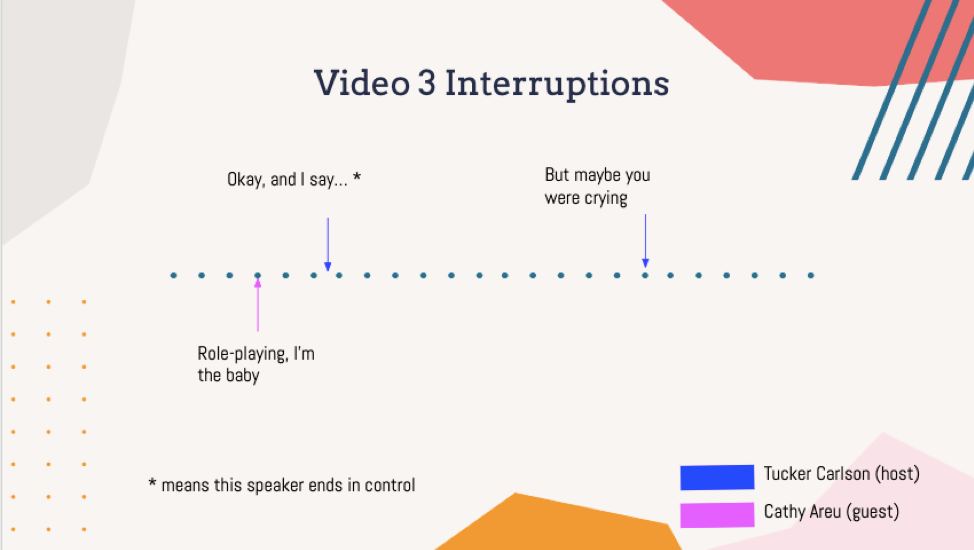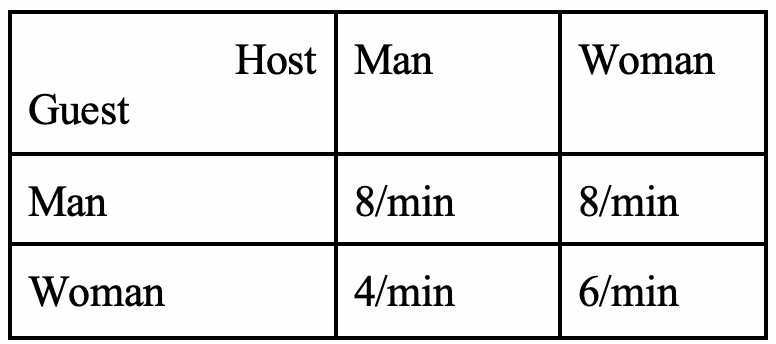Daniel Li, Jennifer Moon, Ming Liang, Minh-Khoa Tran
The present text explores turn-taking by focusing on two prominent models which describe gender differences in communication — the dominance model and the difference model. The idea of deep interruptions is also employed in this study to better measure turn taking during interactions. We are focusing on inter-gender and same-gender interaction by observing talk show hosts engaging in turn-taking with their guests. Our goal is to determine whether or not there is a statistically significant difference between the number of interruptions utilized by men and women during debates in talk shows. Our empirical study analyzes the difference in the average number of interruptions per minute from men and women by using four thirty second clips. Overall, we found that men and women do not differ in terms of the frequency of interruptions but hosts tend to interrupt guests more. It was unexpected that without extensively interrupting, men still try to maintain power and discredit the female speaker through facial expressions or gestures.
Introduction
A lively debate on television is always fun to spectate. When the discussion gets heated, it appears as if power shifts at a moments notice — whoever’s speaking at the time seems persuasive and commanding. Sometimes the structure starts to break down, and the speakers begin interrupting each other in a bid for more speaking time.
Research on turn-taking in conversations has been conducted before. In this blog post, we hope to contribute to the scientific literature on turn-taking by investigating what sort of impact gender may have on the dynamic between talk show hosts and their guests. We’re curious to find out whether or not there is a statistical difference between the frequency of interruptions in mixed gender debates when compared to single gender debates on live television. We are also interested in whether the host and guest relationship will have any impact on the frequency of interruptions and if this plays any role in the dynamic between men and women.
Background Information
There have been numerous studies and established theories about the power dynamic between men and women, and how this manifests itself in spoken language. We expect that the frequency of interruption between men and women will be explained by one of the three major models.
In Deborah Tannen’s difference model, men and women are members of their own distinct culture. This separation between male and female culture means that women and men will take noticeably different approaches to verbal communication (Tannen 1990). These cultures aren’t intrinsically bad or good. Women’s culture isn’t inferior to men’s culture, and it follows that their speech isn’t inferior to men’s speech. Deborah Tannen suggests that the clash of disparate cultures poses problems for respectful and equal communication.
Robin Lakoff proposed a dominance model which asserts that men and women’s unequal places in society’s power structure results in necessarily different communication styles, including how people of different gender are expected to speak and are spoken of (Lakoff 1973). Lakoff suggests that real-world imbalances and inequities will be reflected by linguistic imbalances. These two models both suggest that women and men tend to have distinct speech style and the higher social status of men makes it more likely for men to interrupt in interactions than women.
A very crucial idea that will be utilized in our study is deep interruption, which is an interruption that starts “two or more syllables before or after the last syllable of a place where you’d expect to switch speakers” (West & Zimmerman 1983). West and Zimmerman predict that men are more likely than women to employ deep interruptions. In other words, it is more likely that men would forcefully change the subject of discourse to their desired topic regardless of the previous speaker’s intention.
However, despite the fact that males have been hypothesized to employ interruptions for domination and control, James and Clarke had very contradictory findings; they found an absence of significant differences in the amount of interruptions between women and men (James & Clarke 1993). Therefore, our first hypothesis is that men and women will average a similar number of interruptions per minute towards the other speaker. We also predict that hosts will tend to interrupt more than guests because of power dynamics between hosts and guests.
Methods
To collect data on turn-taking, we first needed to choose clips of debates to analyze. To make sure that we cover each relevant permutation of genders and speakers, we found four video clips. We have two video clips where the genders are the same (man-man, woman-woman). Then we have two more video clips where the genders are different (man-woman, woman-man). We needed two separate gender video clips to see if their status as host or guest on the show would significantly change our results.
Once we gathered our clips, we transcribed a climactic point in the debate where we found the most interruptions occurring. For each clip, we transcribed 30 seconds of debate. We transcribed a video with a man host and man guest which included Piers Morgan and Ben Shapiro. For the woman host and the man guest, we chose a clip with Cathy Newman and Jordan Peterson. For the man host and woman guest, we chose a clip with Tucker Carlson and Cathy Areu. Finally, for the woman host and woman guest, we chose a clip with Poppy Harlow and Janet Porter.
To transcribe the various videos, we used a transcription method of conversation analysis that included turn-taking markers to clearly indicate the turn of the speaker. This also showed whether the host or guest interrupted each other and if the interruptions occurred, we could see at what point the interruption was made during the speaker’s turn. We were also able to see if men had indeed interrupted women more, or if the level of interruptions were similar from both sides. Through this transcription process, we counted token instances of deep interruptions that were made by each speaker. Once the analysis of the deep interruptions was completed, we were able to collect our metrics and form a conclusion based on the amount of deep interruptions that occurred.
Results
To help visualize our results, we plotted interruptions onto a rough timeline. The reasoning for these visual aids was to help us in our qualitative analyses of the clips. The timeline of interruptions helps to capture the flow of conversation and which ideas the most fiery clashes were centered around. Placing them onto a linear timeline also made it clearer which side of the debate was responsible for most of the interruptions. Here are the visualizations for all four of the clips that we analyzed, were time flows from left to right and only the interruptions are marked on the timeline. We have collated our results from the collection of token instances of deep interruption in Table 1.1 and 1.2 that count up these instances of interruption as a function of interruptions per minute.






To summarize, men as hosts interrupted their man guests 8 times per minute and their woman guests 4 times per minute. Women interrupted their man guests 8 times per minute and their woman guests 6 times per minute. Men as guests interrupted their man hosts 2 times per minute and their woman hosts 4 times per minute and women interrupted their man hosts 2 times per minute and their woman hosts 4 times per minute.
Discussion and Conclusion
To touch once more on the focus of this study, we are primarily interested in two dimensions of power in a verbal exchange, the gendered differences between men’s and women’s place in society and social normative expectations, and the dynamic between a host and their guest specifically in the arena of debate talk show. Our predictions based on our original hypothesis following the seminal work of James and Clarke in 1993 stated that we were expecting to not find a significant difference between the rate of interruption from man to woman and woman to man. Our results from analysis of these four clips support this hypothesis, wherein as hosts, people interrupt their guests the same number of times per minute regardless of the guest or host’s gender. In fact, both men and women are less likely as hosts to interrupt their women guests than their man guests, specifically men interrupt their women guests half as often as they interrupt men. However, this is not to say that they were showing their women guests more respect by interrupting less often, rather in these situations the man host controlled the conversation with the woman guest nonverbally.
Qualitative analysis of the accompanying videos show that when a man host is not interrupting a woman verbally he is still displaying physical behaviors that express disbelief or disinterest, which still disrupts the flow of conversation albeit less explicitly. Further, as guests, both men and women interrupt their hosts at very similar rates as well. However, in this situation, both men and women as guests interrupt women hosts more often than they do man hosts (twice as often). To analyze this particular facet of the study we first have to discuss our two big foci of power — man/woman and host/guest. It appears that the more salient dimension of power when it comes to producing significant differences in the rate of interruption is actually host/guest dynamics. As hosts, both men and women produce four times as many interruptions per minute in same gendered interactions.
From here we turn back to our original finding that men and women interrupt at similar rates. While as hosts men and women interrupt their man guests more often than they do their woman guests. As guests they interrupt their woman hosts at twice the rate they do their men hosts. If this host guest dynamic is the most important consideration, this statistic suggests that as the guest and weaker in the dynamic both women and men consider a woman host to hold less power over the course of the debate than a man host as evidenced by their greater willingness to interrupt their host when she is a woman. These observations are preliminary and speculative however and would require much more rigorous control over the interactions including but not limited to: combing through a much greater amount of raw data, controlling for having the same person acting as both guest and host, and developing better accounting methods for nonverbal interruptions.
References
Block, D. (2002). Language and Gender and SLA. Quaderns De Filologia: Estudis Lingüístics, VII, 49–73.
Hoey, E. M. & Kendrick, K. H. (2017). Conversation Analysis. In A. M. B. de Groot & P. Hagoort (Eds.), Research Methods in Psycholinguistics: A Practical Guide (pp. 151 -173). Wiley-Blackwell
James, D. & Clarke, S (1993). Women, Men, and Interruptions: A Critical Review. Critical Reviews of the Literature, 231-279.
Kendall, S., & Tannen, D. (2015). Gender and Language in the Workplace. Gender and Discourse Gender and Discourse, 81–105. doi: 10.4135/9781446250204.n5
Lakoff, R. (1973). Language and Woman’s Place. Language in Society, 2, 45–80.
Tannen, D. (2012). Turn-Taking and Intercultural Discourse and Communication. The Handbook of Intercultural Discourse and Communication, 135–157. doi: 10.1002/9781118247273.ch8
West, C., & Zimmerman, D. (1987). Doing Gender. Gender and Society, 1(2), 125-151. Retrieved from http://www.jstor.org/stable/189945